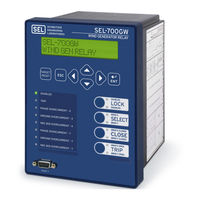Schweitzer Engineering Laboratories SEL-700G1 Manuals
Manuals and User Guides for Schweitzer Engineering Laboratories SEL-700G1. We have 1 Schweitzer Engineering Laboratories SEL-700G1 manual available for free PDF download: Instruction Manual
Schweitzer Engineering Laboratories SEL-700G1 Instruction Manual (824 pages)
Generator and Intertie Protection Relays
Brand: Schweitzer Engineering Laboratories
|
Category: Relays
|
Size: 15 MB
Table of Contents
-
Preface
23-
Conventions28
-
-
Overview33
-
Features33
-
Applications39
-
-
-
Overview53
-
-
-
Overview91
-
Setup92
-
Terminal93
-
Settings96
-
Event Analysis100
-
-
-
Application Data109
-
Other Settings286
-
-
-
Overview345
-
Metering346
-
Load Profiling358
-
Breaker Monitor359
-
-
-
Overview371
-
-
-
Overview445
-
-
-
Overview493
-
-
-
Overview511
-
Event Reporting512
-
-
-
Overview543
-
Testing Tools543
-
Self-Test555
-
Troubleshooting558
-
-
-
-
Overview605
-
-
-
Overview635
-
-
-
Features687
-
Logical Nodes704
-
-
-
Overview735
-
Devicenet Card735
-
Features736
-
-
-
Overview739
-
Advertisement
Advertisement
Related Products
- Schweitzer Engineering Laboratories SEL-700G Series
- Schweitzer Engineering Laboratories SEL-700G0
- Schweitzer Engineering Laboratories SEL-700GT
- Schweitzer Engineering Laboratories SEL-700GW
- Schweitzer Engineering Laboratories SEL-701
- Schweitzer Engineering Laboratories SEL-787
- Schweitzer Engineering Laboratories SEL-787-2
- Schweitzer Engineering Laboratories SEL-787-2E
- Schweitzer Engineering Laboratories SEL-787-4X
- Schweitzer Engineering Laboratories SEL-749M
